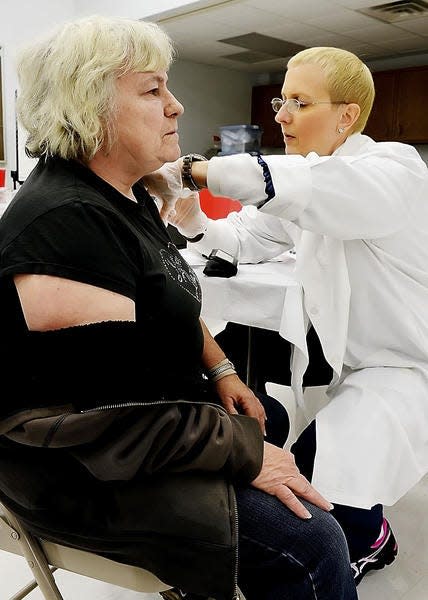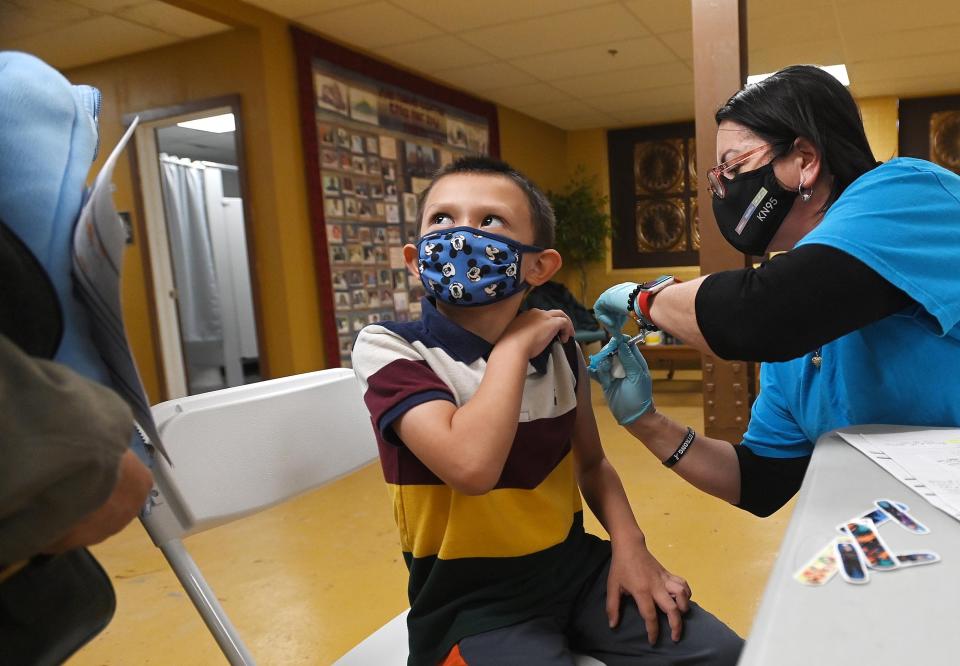Mix of COVID, colds, flu and RSV creating unique coalition of viruses in western PA
- Oops!Something went wrong.Please try again later.
PITTSBURGH - While the flu and COVID-19 have very similar symptoms, 22-year-old Mason Strawn remembers the fight against COVID being much more intense than sniffles and coughs.
“Unlike the flu, COVID caused physical pain when I had it,” Strawn said. “When I had the flu, I felt bad in a sick way, with congestion, coughs and such. But with COVID, I had physical aches and pains, it even hurt to cough. Losing your sense of taste and smell was also rough.”
COVID experience:A different type of patient: COVID nurses, doctors share their experiences
As the cold weather of the fall season increases the spread of these airborne viruses in western Pennsylvania, many people in the region are facing a dilemma when trying to diagnose their illness due to the similar symptoms caused by colds, the flu and COVID-19. Without proper testing and close attention to the severity of symptoms, it can quickly become confusing for patients to decide their next steps.

“Unfortunately, the problem is so many of the symptoms overlap,” said Dr. Brian Lamb, a cardiovascular disease expert at Allegheny Health Network. “Trying to tell what it is just based on a phone call or based on symptoms is nearly impossible.”
While the least severe of the seasonal illnesses, colds are most commonly seen during this time of year. As the weather begins to shift, the virus is easily spread to others and can cause coughing, headaches, body aches and sneezing. Guidance from the Centers for Disease Control notes that there is no cure for a cold, but patients typically recover in 7 to 10 days.
One of the first issues for Lamb and other doctors is the changing trends for the flu season, which is slowly creeping into the fall season. While the flu is traditionally associated with the winter months, cases are beginning to occur earlier than expected.
“A lot of times we used to think that the flu season was from January until March, but we're seeing it now,” Lamb said. “So the flu is already starting to firmly establish itself.”
According to doctors at UPMC, AHN and Heritage Valley, patients diagnosed with the flu are currently on the rise in the greater Pittsburgh region and numbers are slightly above normal for this time of year. It is important to note this data also only reflects those actively reporting their cases to doctors, as some families may opt to treat the virus on their own.
“As of Nov. 5, influenza A is the predominant one,” said Dr. Alexandra Potock, an expert on internal medicine at the UPMC Passavant. “As of then, we reported 2079 cases of the flu in Allegheny County, as opposed to around 155 cases last year. So, it’s definitely on the rise.”

When diagnosing patients with the flu, doctors often assess the severity of the cold-like symptoms in their patients. While common colds are mild for the typical patient, the flu typically exhibits more intense physical responses from people.
“Influenza has a more abrupt onset of fever and symptoms than the typical common cold,” said Dr. Michael Cratty, vice president and chief medical officer for Heritage Valley Health System. “People with the flu typically will have myalgias, muscle aches. COVID and flu infections can have similar symptoms such as headache, fatigue, cough, sore throat, runny nose, fever and possibly diarrhea.”
Many of the symptoms of the flu are shared with COVID-19, making it much more difficult to distinguish the two viruses without testing. While some of the symptoms associated with the coronavirus are unique, including a lack of taste or smell and more intense breathing issues, cases can also be asymptomatic or cause different reactions for people.
“Each person is very different,” Potock said. “One of the ways that we can kind of differentiate a little bit better is that the fatigue with COVID-19 is more severe and patients can have really bad headaches. They also can get some GI symptoms like nausea, vomiting, and diarrhea. Loss of taste and smell seems to be the most common sign of COVID.”
When experiencing these flu-like symptoms, the best practice is often to get tested before moving forward and avoid contact with others whenever possible.
“It's very important to test and rule out COVID and then, a lot of times, to retest,” Lamb said. “We have to remember that those home tests are more accurate if you let the symptoms develop for a few days. So if you tested the very beginning, you may not catch enough of the viral load in the antigen.”
Data from the CDC and Allegheny County Health Department indicate that the community level of COVID-19 was ranked “low” as of the week of Nov. 9, with a positive case rate of around 79 people per population of 100,000 county residents. This averages to more than 950 total cases for the region. Total deaths have also remained relatively low, with 19 deaths attributed to the virus during the week of Nov. 2.
This is a significant improvement from last year's transmission rate, with USA Today reporting 4,714 cases of COVID-19 within Allegheny County and 33 deaths as of Nov. 16, 2021. During that week, reporters also noted that the region was the largest source of new cases in the state.
While Beaver County lacks a dedicated health department, reported cases of COVID-19 also remain low for the region compared to last year's statistics. On Oct. 18, Beaver County reported 149 cases of COVID-19 and no deaths. In this same time period in 2021, the county had reported 587 cases and 12 deaths.

While these case numbers look promising on paper, these reports may be misleading due to the popularity of at-home COVID testing. While the previous reporting relied on lab numbers, reporting of at-home testing is not required and many cases are not reported to local health departments.
In addition to the nasty cocktail of viruses already circling this season, another virus is also causing trouble for some local children. Recent reports from UPMC Children’s Hospital of Pittsburgh have noted a rise in reported cases of the respiratory syncytial virus (RSV) among young patients and some cases arising in adults around the region.
Beaver County real estate market:How hot is the real estate market near Beaver? Home sale prices stable at $180K
Like the flu and COVID, the CDC says that RSV shows cold-like symptoms and is particularly dangerous in infants and older adults. As families try to identify illnesses, this may be another option that requires lab testing to properly identify the virus.
“Unfortunately, this year we're adding this fourth viral infection,” Lamb said. “RSV has always been around and was usually considered a childhood disease, but we are seeing it more in adults. We are going into a season of four rapidly circulating viruses and trying to tell the difference between viruses can be very, very difficult.”
No matter what virus patients may contract, doctors recommend staying home when sick to prevent the spread of illnesses.
“One of the big things is staying home when you don't feel good,” Lamb said. “I know that's unpopular with a lot of people. We have to work, our kids have to go to school. We're always in that mentality where we go to work when we're sick, we think it's almost like a badge of courage. But it's one of the worst things you can do. If you're sick, you're going to spread it.”
With the holiday season in full swing, this may also mean making some tough decisions when inviting people over to celebrate.
“The holiday season is tough since you have Thanksgiving and everybody's hanging out together,” Potock said. “If you know someone's sick, I would just try to avoid them or don't go over to their home. If you are sick, don't invite people over to your house.”
Another tip for preventing the spread of these viruses is ensuring families keep their vaccines up to date. This can include annual flu shots, the COVID-19 vaccine and the associated boosters. Updated vaccinations are also the best way to mitigate the risks of getting sick or having severe complications with their symptoms.
The public is asked to remember diligent hand washing after interacting with high-contact areas, especially as these viruses continue to be spread indoors during the cold weather. If interacting with large crowds, it is also beneficial to wear facemasks to avoid being exposed to any of these illnesses.

“I usually tell people if you're going to a high transmission area, wear a mask,” Potock said. “The masks do decrease transmission of respiratory droplets, so it will help prevent the spread of influenza, RSV, colds and COVID.”
If patients do start to experience cold or flu-like symptoms, there are some over-the-counter treatments available to help with symptoms. Doctors recommend painkillers, such as Tylenol, for headaches and other physical discomforts. For those battling a cough, over-the-counter cough syrups can also provide some relief from symptoms.
In cases where symptoms become extreme, especially for those with pre-existing conditions, consulting a professional is recommended for maximum safety. In situations where an at-risk patient is battling COVID-19 or RSV, special prescriptions and treatments may be required.
“There are treatments to reduce the severity and duration of symptoms for the flu with Tamiflu depending on the onset of symptoms, patient's risk of complications and the severity of the illness,” Cratty said. “For COVID infections, Paxlovid can be used as treatment in patients with high risk for complications. Remdesivir can also be used for COVID treatment in these patients with high risk of complications by disease given intravenously. New COVID omicron variants have led to reduced effectiveness of monoclonal antibody therapies in most cases.”
Christmas tree festival:Beaver County Christmas Extravaganza returns to Bradys Run lodge
This article originally appeared on Beaver County Times: Western PA dealing with mix of respiratory illnesses

